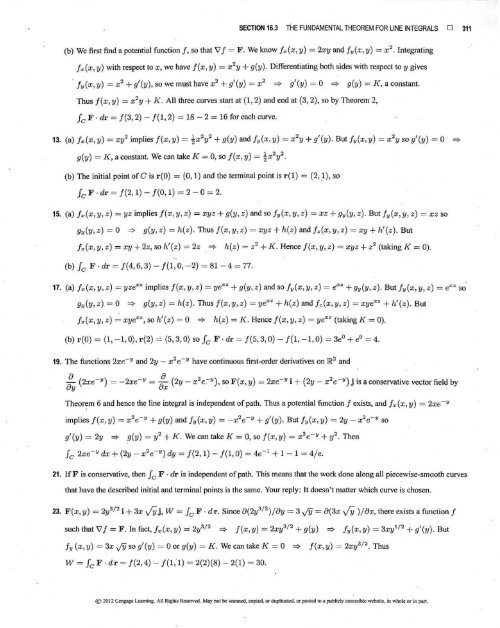Exercicios resolvidos James Stewart vol. 2 7ª ed - ingles
You also want an ePaper? Increase the reach of your titles
YUMPU automatically turns print PDFs into web optimized ePapers that Google loves.
SECTION 16.3 THE FUNDAMENTAL THEOREM FOR LINE INTEGRALS 0 311<br />
(b) We first find a potential function f, so that \l f = F. We know ! :r:(x, y) = 2xy and jy(x, y) = x 2 • Integrating<br />
fx(x, y) with respect to x, we have f(x, y) = x 2 y + g(y). Differentiating both sides with respect toy gives<br />
· J 11<br />
(x, y) = x 2 + g'(y), so we must have x 2 + g'(y) = x 2 =? g'(y) = 0 => g(y) = K, a constant.<br />
Thus f(x, y) = x 2 y + K. All three curves start at (1, 2) and end at (3, 2), so by Theorem 2,<br />
fe F · dr = !(3, 2) - !(1, 2) = 18 - 2 = 16 for each curve.<br />
13. (a) f r(x, y) = xy 2 implies J(x, y) = ~x 2 y 2 + g(y) and fy (x, y) = x 2 y + g'(y). But /y(x, y) = x 2 y so g'(y) = 0 =><br />
g(y) = K, a constant. We can take K = 0, so f(x, y) = ~x 2 y 2 .<br />
(b) The initial point of C is r (O) = (0, 1) and the terminal point is r(1) = (2, _1), so<br />
fe F · dr = /(2, 1) - f(O, 1) = 2 - 0 = 2.<br />
15. (a) f x(x, y, z ) = yz implies f(x, y, z) = xyz + g(y, z) and so jy(x, y , z) = xz + g 11 (y, z). But jy(x, y, z) = xz so<br />
gy(y, z ) = 0 => g(y, z) = h(z). Thus f(x, y, z) = xyz + h(z) and f:(x, y, z) = X'!f + h'(z). But<br />
f:(x, y, z) = xy + 2z, so h'(z) = 2z => h(z) = z 2 + K.. Hence f(x, y, z) = xyz + z 2 (taking J( = 0).<br />
(b) fe F · dr = !(4,6,3)-!(1, 0, - 2) = 81 - 4 = 77.<br />
17. (a) f:r:(x, y, z) = yze"'= implies f(x, y, z) = ye"'= + g(y, z) and so fv(x, y, z) = e"'= + gy(y, z). But jy(x, y, z ) = e"'= so.<br />
gy{y,z) = 0 =? g(y,z) = h(z). Thus f(x,y,z)·= ye"'= + h(z) and fz(x, y,z) = xyex= + h'(z). But<br />
f:.:(x,y,z) = xyex=, so h'(z) = 0 =? h(z) = K. Hence f(x,y,z) = ye"'= (taking!(= 0).<br />
(b) r (O) = (1, -1, 0), r(2) = (5, 3, 0) so fe F · dr = /(5, 3, 0) - /(1, - 1, 0) = 3e 0 + e 0 = 4.<br />
19. The functions 2xe-Y and 2y - x 2 e- v have continuous first-order derivatives on JR 2 and<br />
~ (2xe-v) = -2xe- Y = ~ (2y- x 2 e:-v), so F(x, y) = 2xe-Y i + (2y- x 2 e-Y) j is a conservative vector field by<br />
Ulj vx . .<br />
Theor~m 6 and hence the line integral is independent of path. Thus a potential function f exists, and fx(x, y) = 2xe-v<br />
implies f(x, y) = x 2 e- 11 + g(y) and fv(x, y) = - x 2 e-Y + g'(y). But fv(x, y) = 2y- x 2 e-v so<br />
g'(y) = 2y =? g(y) = y 2 + K. We can take K = 0, so f(x,y) = x 2 e- 11 + y 2 • Then<br />
.fe 2xe-v dx + (2y - x 2 e- v) dy = /(2, 1) - f(l, 0) = 4e- 1 + 1 - 1 = 4/e.<br />
21. IfF is conservative, then fe F · dr is independent of path. This means that the work done along all piecewise-smooth curves<br />
that have the describ<strong>ed</strong> initial and terminal points is the same. Your reply: It doesn't matter which curve is chosen.<br />
23. F (x, y) = 2y 3 1 2 i + 3x Jyj, W = .fe F · dr. Since 8(2y 3 1 2 )/8y = 3 y'Y = 8(3x Jy )/ ax, there exists a function f<br />
suchthat\lf=F.Infact,fx(x, y)='2y 3 1 2 => f(x,y)=2xy 312 +g(y) => fv(x,y)=3xy 1 1 2 +g'(y). But<br />
/y (x, y) = 3x y'Y so g'(y) = 0 or g(y) = K. We can take I< = 0 =? f(x, y) = 2xy 3 1 2 • Thus<br />
W = fe F · dr = j(2, 4) :.... j(I,·l) = 2(2)(8)- 2(1) .= 30.<br />
© 2012 Ccngogc Leoming. All Rights Resen'Od. May nol b< scann<strong>ed</strong>, copi<strong>ed</strong>. orduplicalcd. or posl


